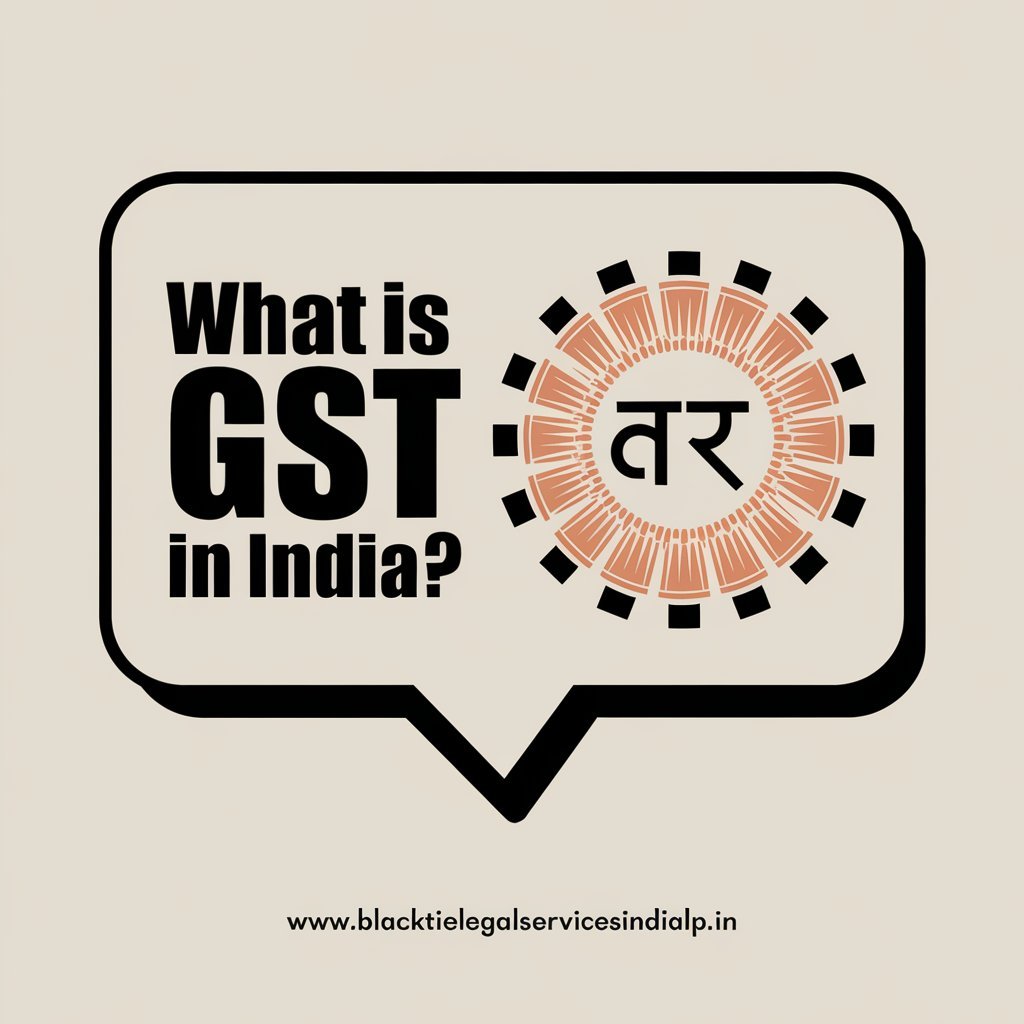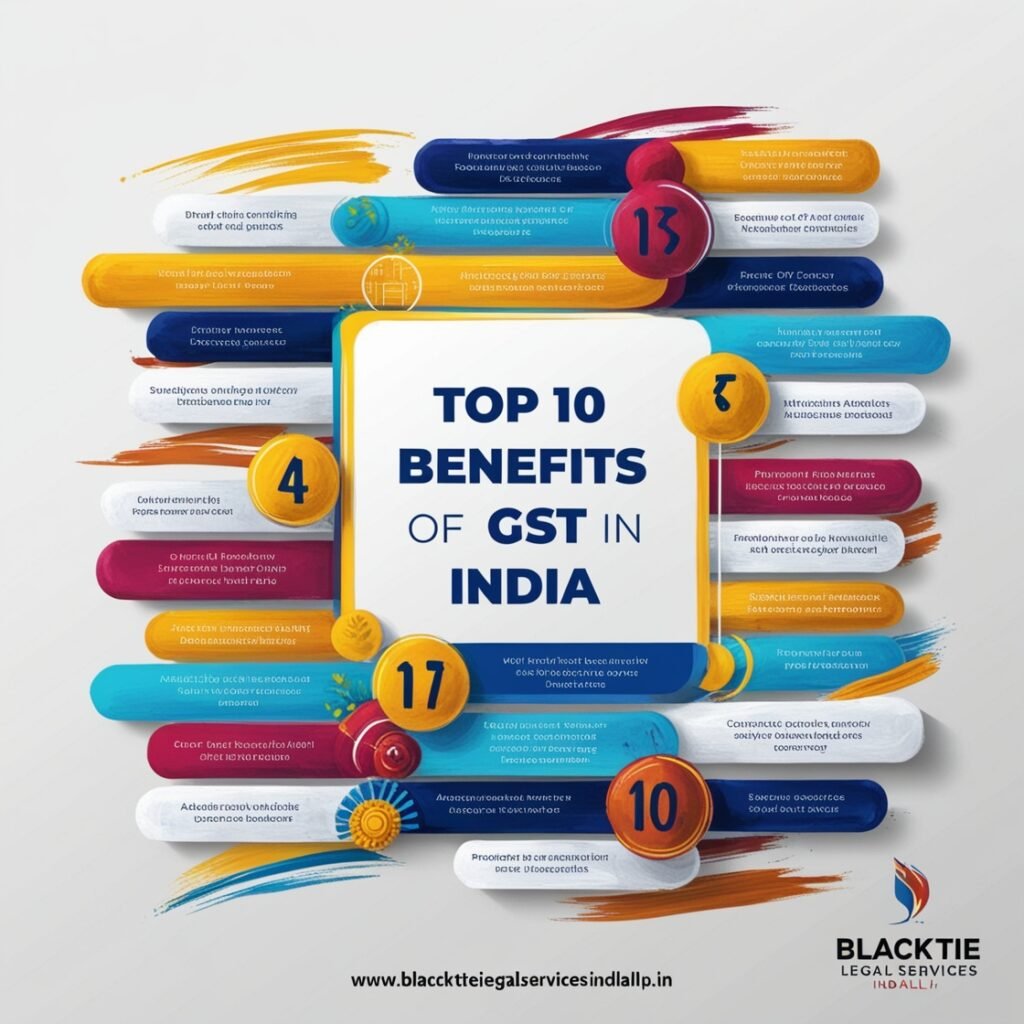In this blog, we explore the top 10 benefits of GST and its transformational impact on businesses, consumers and the Indian economy. The Goods and Services Tax (GST), implemented on July 1, 2017, is one of India’s most significant tax reforms. It replaced several indirect taxes, simplified the tax structure and promoted a unified national market. GST streamlines compliance, promotes transparency, reduces costs, and boosts economic growth.
- What is the GST in India?
- What are the Top 10 Benefits Of GST in India?
- 1. Efficient Logistics
- 2. Input Tax Credit
- 3. Reduces Tax Cascading
- 4. Compliance Burden
- 5. Higher Threshold for Registration
- 6. After GST
- 7. Higher Tax Burden of SMEs
- 8. Increased Revenue
- 9. Removal of Cascading
- 10. Composition Scheme
- Conclusion:
- FAQs
- Q1. What are the significant benefits of GST?
- Q2. How can I get GST benefits?
- Q3. What is the benefit of filing a GST return?
- Q4. What are GST’s essential points?
- Q5. What is the monthly return in GST?
- Q6. What is the GST number and what are its benefits?
- Q7. Which of the following are the benefits of GST Mcq?
What is the GST in India?
Goods and Services Tax (GST) is a comprehensive indirect tax system implemented in India on July 1, 2017, under the GST Act. It has replaced indirect taxes like excise duty, VAT, and service tax. GST is a destination-based tax, meaning it is levied at the point of consumption rather than the point of origin.
1. Dual structure: Central GST (CGST), State GST (SGST), and Integrated GST (IGST).
2. Tax Slabs: 0%, 5%, 12%, 18% and 28%.
3. Input Tax Credit (ITC): Reduces tax liability by crediting taxes paid on inputs.
4. Comprehensive coverage: This applies to most goods and services except liquor and petroleum.

What are the Top 10 Benefits Of GST in India?
1. Efficient Logistics
2. Input Tax Credit
3. Reduces Tax Cascading
4. Compliance Burden
5. Higher Threshold for Registration
6. After GST
7. Higher Tax Burden of SMEs
8. Increased Revenue
9. Removal of Cascading
10. Composition Scheme
To Registration of GST and GST Return Filing Contact Our Expert Team

1. Efficient Logistics
One of the significant benefits of GST in India is improved logistics efficiency. Before GST, interstate trade was plagued by various taxes such as octroi and entry tax and long waiting times at state borders for inspection. GST has eliminated these bottlenecks.
1. Seamless movement: Goods can now move seamlessly between states.
2. Faster transit: Reduction in delays at borders.
3. Low cost: savings on transportation and storage.
4. Improved supply chain: Centralized storage and better route planning.
2. Input Tax Credit
Input Tax Credit (ITC) is a fundamental Goods and Services Tax (GST) feature. It allows businesses to reduce tax liability by claiming credit for taxes on inputs (goods or services) used for business purposes.
1. Tax liability is reduced: Businesses pay tax only on value addition.
2. Prevents double taxation: Eliminates the cascading effect of taxes.
3. Promotes transparency: Encourages businesses to maintain proper records.
3. Reduces Tax Cascading
In the pre-GST regime, there was a “cascading effect”, where taxes were levied on top of other taxes, increasing the cost of goods and services. GST eliminates this issue by allowing businesses to claim input tax credit (ITC) on taxes paid for production or supply chain inputs.
In the old system, excise duty was levied on the product’s manufacturing cost, and then VAT was imposed on the selling price, including excise duty.
Under GST, only value addition is taxed at each stage, as ITC compensates for taxes already paid.

4. Compliance Burden
GST has simplified taxation and brought a compliance burden, especially for small and medium enterprises (SMEs). Here’s an overview benefits of GST.
1. Multiple Returns: Businesses must file multiple returns like GSTR-1, GSTR-3B and GSTR-9.
2. Strict deadlines: There is a penalty for missing the filing deadline.
3. Invoice Matching: Detailed reporting is required to claim Input Tax Credit (ITC).
4. E-way bill: Mandatory for transporting goods worth more than a specific value.
5. E-invoicing: Required for businesses above a specific turnover limit.
6. Frequent updates: Regular legal changes require constant monitoring.
5. Higher Threshold for Registration
The threshold for mandatory registration under GST is much higher than the previous tax regime. Businesses with annual turnover exceeding the following thresholds are exempted from GST registration.
₹40 lakh: For most commodity suppliers (₹20 lakh for service providers).
₹20 lakh: For smaller states (₹10 lakh in specific cases).
This higher limit reduces the compliance burden for small businesses, allowing them to focus on growth without worrying about tax complexities.
6. After GST
1. Unified Tax System: GST replaced multiple taxes like VAT and excise duty with one simplified tax.
2. Streamlined compliance: Businesses file returns and pay taxes online, simplifying the process.
3. Eliminating Cascading Taxes: GST eliminates tax-on-tax, reducing the overall tax burden.
4. Input Tax Credit: Businesses can now offset taxes paid on inputs, thereby reducing final tax liabilities.
5. Lower consumer prices: Lower tax rates on many goods and services led to lower prices.
6. Boost cross-border trade: Integrated GST simplified inter-state transactions, increasing trade.
7. Increase in formality: GST encourages transparency and proper record-keeping in business.
8. Simplified filing: Fewer returns and digital filing made compliance more manageable.
9. Improved tax collection: GST improved tax revenue by reducing tax evasion and ensuring accountability.
10. Economic Growth: Simplified taxation increases business efficiency, attracts investment and promotes growth.
7. Higher Tax Burden of SMEs
Benefits of GST Small and medium enterprises (SMEs) in India face a high tax burden due to several challenges.
1. Complex compliance: SMEs struggle with detailed GST returns and tax filings, which leads to increased administrative costs.
2. Cash flow problems: Paying GST before receiving payment causes financial stress.
3. Limited Input Tax Credit (ITC): SMEs cannot fully utilise ITC, which increases their tax burden.
4. High compliance costs: SMEs must incur accounting, software and professional services expenses.
5. Unfavorable tax slabs: Higher GST rates on certain items can reduce profit margins.
6. Lack of awareness: Many SMEs face penalties due to non-compliance or incorrect filings.
7. Reverse Charge Mechanism (RCM): Some SMEs have to pay tax on unregistered dealer purchases, which increases costs.
8. Logistics and e-way bills: Managing e-way bills and transportation delays adds costs.

8. Increased Revenue
GST has significantly improved government revenue collection due to its comprehensive and streamlined structure.
1. Wider tax base: GST has brought more businesses into the formal economy, thereby increasing the taxpayer pool.
2. Efficient compliance: Technology-driven processes such as e-invoicing, e-way bills, and regular return filing reduce tax evasion.
3. Integrated System: Integrating multiple taxes into GST ensures a consistent and efficient revenue flow.
4. Higher Transparency: GST’s digital tracking mechanisms increase accountability and reduce revenue leakages.
9. Removal of Cascading
The cascading effect, also known as “tax on tax”, occurs when a product is taxed at each stage of the supply chain while not providing credit for taxes paid at earlier stages. GST eliminates this by allowing businesses to claim input tax credit (ITC) for taxes paid on purchases.
Before GST: A manufacturer paid excise duty on raw materials and VAT on the final product, which was calculated separately, leading to a cascading effect.
Under GST: The manufacturer can claim credit for GST paid on raw materials, reducing the final tax liability.
10. Composition Scheme
The composition scheme simplifies GST compliance for small businesses, allowing them to pay a fixed tax rate on turnover instead of the regular GST rates.
1. Eligibility: Businesses with annual turnover up to ₹1.5 crore (₹75 lakh for unique category states).
2. Tax Rates:
1% for manufacturers and traders.
5% for restaurants (non-alcoholic).
3. No Input Tax Credit: ITC cannot be claimed on purchases.
4. Limited circulation: For intra-state sales only; inter-state trading is not permitted.
5. Lower compliance: Quarterly returns (GSTR-4) and simplified annual filing.
Conclusion:
The introduction of GST has revolutionized India’s tax system, creating a more integrated and transparent economy. It eliminates the cascading effect of taxes, simplifies compliance, and reduces the tax burden for businesses and consumers. Through promoting a seamless national market, encouraging formalization, and promoting transparency, GST has contributed significantly to India’s economic growth. Its long-term benefits, such as increased government revenues, lower logistics costs, and reduced consumer prices, make it a transformational reform. GST simplifies taxation and strengthens India’s position as a competitive global economy.
FAQs
Q1. What are the significant benefits of GST?
GST simplifies taxation, eliminates cascading taxes, reduces costs, and promotes an integrated national market. It increases transparency and government revenue, supports economic formality, and lowers consumer prices.
Q2. How can I get GST benefits?
Register for GST, claim an input tax credit (ITC) on purchase, file regular returns and select the option of composition scheme if you are eligible to reduce tax liability.
Q3. What is the benefit of filing a GST return?
Filing GST returns ensures compliance with tax laws and permission to claim an input tax credit (ITC) and promotes transparency in financial transactions. This helps avoid punishment, increases business reliability, and contributes to the smooth operation of the tax system.
Q4. What are GST’s essential points?
Many taxes were replaced by the integrated system. This includes CGST, SGST and IGST. Tax rates: 0%, 5%, 12%, 18%and 28%. Provides input tax credit (ITC). Destination-based tax applied to consumption. Cover most goods/services except alcohol and petroleum through digital filing and payment through the GST portal.
Q5. What is the monthly return in GST?
The monthly return in GST refers to GSTR-3B, a monthly self-decoration form filed by taxpayers to report, purchase, and input tax credit (ITC) and tax liability. It is mandatory for all regular GST-regional businesses to avoid punishment it should be filed by 20th of next month.
Q6. What is the GST number and what are its benefits?
Legal compliance.
Claim input tax credit.
Make interstate trade simple.
Promote business reliability.
Necessary for government tenders.
Q7. Which of the following are the benefits of GST Mcq?
GST benefits include:
Eradication of cascading taxes.
Simplified tax structure.
Promotion of economic development.
Increased transparency.
Logistics cost reduction.


Add a Comment